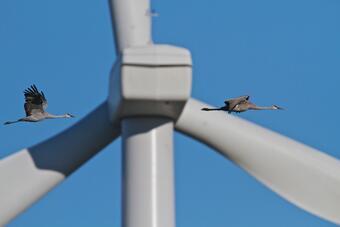Today, the alternative energy and telecommunications industries are developing the airspace much the way metropolitan growth and mechanized agriculture develop the landscape. NOROCK scientists and partners are using both historical and traditional technologies in new and innovative ways to observe wildlife behaviors in response to these changing habitats.

Today, the alternative energy and telecommunications industries are developing the airspace much the way metropolitan growth and mechanized agriculture develop the landscape. NOROCK scientists and partners are using both historical and traditional technologies in new and innovative ways to observe wildlife behaviors in response to these changing habitats. In regions developing wind power, radar and thermal imagery are used to study bird and bat behavior in ways that contribute to their conservation and management. This research group is attempting to understand why bats suffer higher mortality than birds during nighttime flight in the vicinity of wind turbines. Evidence is accumulating that migrating birds avoid wind turbines while bats may be attracted to them, perhaps as foraging or social gathering locations. Research into the impacts of alternative energy continues this year in planned research using the same technologies will examine how birds and bats respond to solar energy facilities. Where alternative energy does impact birds and bats, the USGS is interested in working with industry and other partners to develop ways to mitigate the impacts of alternative energy on wildlife and preserve the ecological services and economic benefits provided by these animals.
Below are news stories associated with this project.
Today, the alternative energy and telecommunications industries are developing the airspace much the way metropolitan growth and mechanized agriculture develop the landscape. NOROCK scientists and partners are using both historical and traditional technologies in new and innovative ways to observe wildlife behaviors in response to these changing habitats.

Today, the alternative energy and telecommunications industries are developing the airspace much the way metropolitan growth and mechanized agriculture develop the landscape. NOROCK scientists and partners are using both historical and traditional technologies in new and innovative ways to observe wildlife behaviors in response to these changing habitats. In regions developing wind power, radar and thermal imagery are used to study bird and bat behavior in ways that contribute to their conservation and management. This research group is attempting to understand why bats suffer higher mortality than birds during nighttime flight in the vicinity of wind turbines. Evidence is accumulating that migrating birds avoid wind turbines while bats may be attracted to them, perhaps as foraging or social gathering locations. Research into the impacts of alternative energy continues this year in planned research using the same technologies will examine how birds and bats respond to solar energy facilities. Where alternative energy does impact birds and bats, the USGS is interested in working with industry and other partners to develop ways to mitigate the impacts of alternative energy on wildlife and preserve the ecological services and economic benefits provided by these animals.
Below are news stories associated with this project.

